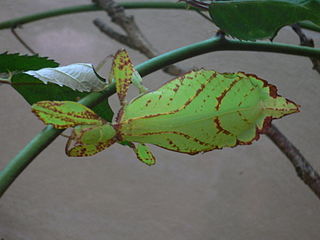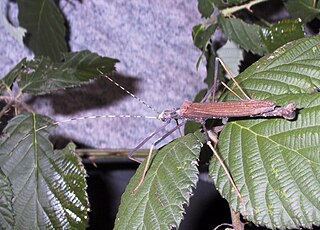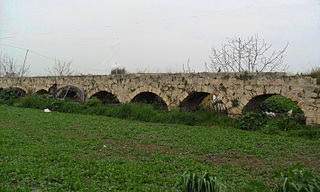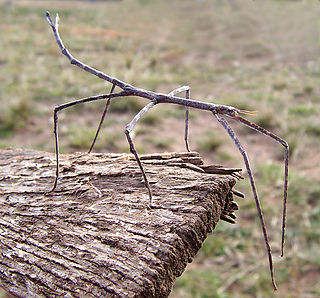
The family Phylliidae contains the extant true leaf insects or walking leaves, which include some of the most remarkably camouflaged leaf mimics (mimesis) in the entire animal kingdom. They occur from South Asia through Southeast Asia to Australia. Earlier sources treat Phylliidae as a much larger taxon, containing genera in what are presently considered to be several different families.

The Phasmatidae are a family of the stick insects. They belong to the superfamily Anareolatae of suborder Verophasmatodea.

Phobaeticus is a genus of Asian stick insects comprising over 25 species.

Phyllium is the largest and most widespread genus of leaf insects in the family Phylliidae (Phasmatodea). They can be found in Sundaland, Philippine Islands, Wallacea, Australasia.

Pseudophasmatidae is a family of stick insect, in the suborder Verophasmatodea, commonly called the "striped walkingsticks". An important identifying characteristic is its mesothorax, which is never more than three times as long as the prothorax.

Anchiale austrotessulata, the tessellated stick insect, tessellated phasmid or tessulata stick insect, is a medium-sized, stick insect found in the Brisbane area of Australia. Fully grown males in mating season exhibit frenetic behaviour. This species is also parthenogenetic.

Anchiale or Anchialeia was a historic city of ancient Cilicia now a part of modern Mersin, Turkey. It was inhabited during the Hellenistic, Roman, and Byzantine eras.

The Clitumninae are a sub-family of stick insects in the family Phasmatidae found in Asia. The type genus Clitumnus is now considered a synonym of Ramulus.

The Lonchodinae are a subfamily of stick insects in the family Lonchodidae found in: Australasia, Asia, Africa, Southern America and the Pacific.

Phasmatini is a tribe of stick insects in the family Phasmatidae. There are more than 40 described species, found in Australasia, Asia and possibly Brazil.

Phasmotaenia is a genus of phasmids belonging to the family Phasmatidae.

Heteropterygini is the only tribe within the subfamily of the Heteropteryginae from the order of the Phasmatodea in the family Heteropterygidae. With 19 representatives described, this subfamily represents both the species-poorest and that of the three subfamilies, to which the largest and most striking species are counted.

The Cladomorphinae are a subfamily of stick insects in the family Phasmatidae. This taxon is particularly well represented in the Neotropical region, but records also exist for Madagascar, Java and the Maluku Islands.
Nesiophasma is a genus of very large stick insects within the order Phasmatodea and the tribe of Stephanacridini. Known species occur in Sulawesi, Selayar Island south of Sulawesi, Sangir Island, Lesser Sunda Islands, and New Guinea. The largest in the list of species is Nesiophasma giganteum, with females reaching a body length of 30 cm.
Anchiale buruense is a medium-sized stick insect found in Buru of the Maluku Islands, Indonesia.
Anchiale modesta is a medium-sized stick insect from Papua New Guinea.
Anchiale stolli is a medium-sized stick insect found in the Solomon Islands.
Anchiale marmorata is a medium-sized stick insect found in Papua New Guinea. This species is very similar to Anchiale modesta but females are smaller in size and have shorter legs.
Anchiale maculata is a medium-sized stick insect found on the Maluku Islands, Peleng Island and Kei Islands. Anchiale maculata was first described by Oliver in 1792 as Mantis maculata. The genus Anchiale was introduced by Stål (1875) with the type species Anchiale maculata.












